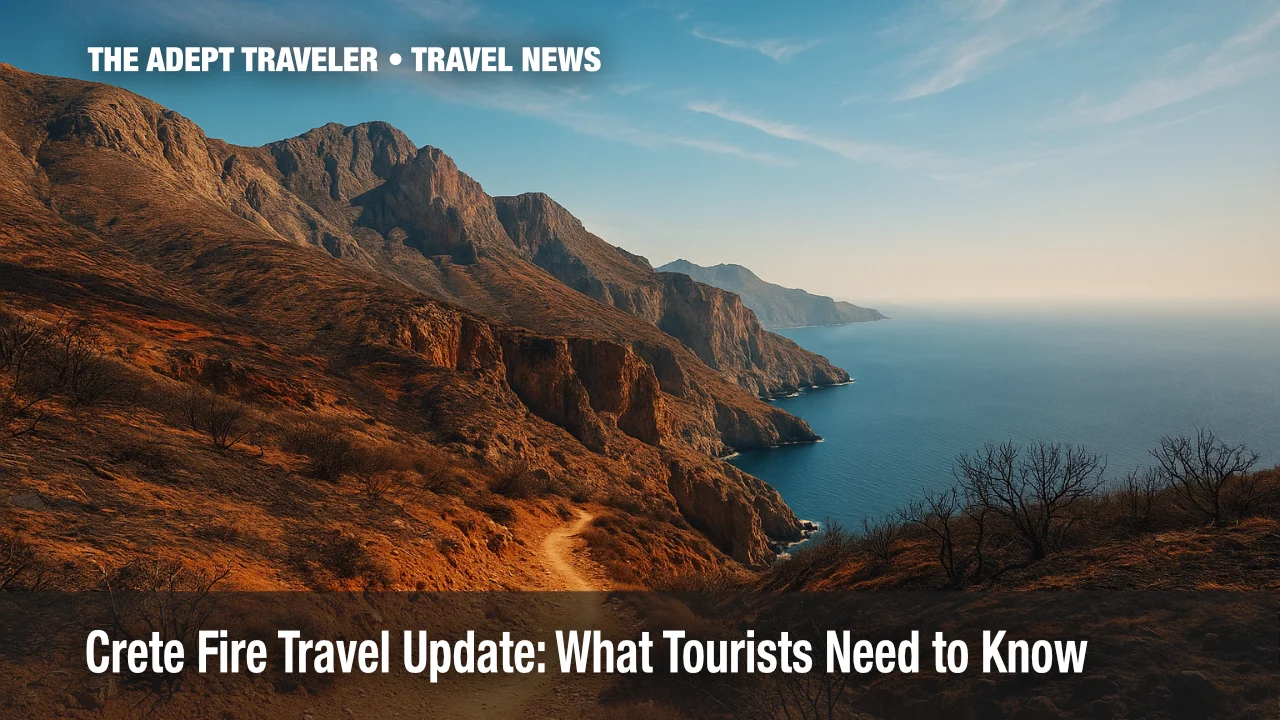Crete Fire Travel Update: What Tourists Need to Know

The Crete fire that flared on July 3 has become the largest active wildfire in Greece so far this summer, forcing more than 1 500 residents and travelers from coastal villages near Ierapetra. With peak season in full swing, many travelers are asking whether it is still safe to visit, how the blaze affects flights and ferries, and what happens to their money if plans change. Below is an up-to-date briefing for anyone concerned about wildfires in Crete or broader travel safety in Greece.
Key Points
- Evacuation orders issued for five villages south-east of Ierapetra.
- Airport and ferry terminals operating; minor smoke delays only.
- Why it matters: July and August are historically Greece's highest fire-risk months.
- Package-tour refunds apply only if your provider cancels the trip.
- EU 261 treats wildfires as "extraordinary circumstances," so compensation is limited.
Crete Fire Snapshot - How It Works
Wildfires in Crete spread quickly because summer meltemi winds can reach Force 7-9. According to Greece's Civil Protection Ministry, 230 firefighters, 10 helicopters, and 46 engines are now committed to the Ierapetra front, while a separate 160-strong unit continues mop-up in Halkidiki. Emergency SMS alerts (number 112) go out automatically to mobile phones registered on Greek networks. Tourist police at Heraklion and Chania airports relay the same alerts in English and German. If you receive a message reading "WILDFIRE. Evacuate to Makry Gialos Marina," follow the route on the attached map; buses and Coast Guard launches are standing by.
Crete Fire Background - Why It Matters
Greece's wildfire season officially runs May 1 - October 31. Over the past decade, wildfires in Crete have been less frequent than on Rhodes or the Attica mainland, but 2023 and 2024 both recorded multi-day blazes in the Lasithi prefecture. Local authorities upgraded evacuation protocols after the 2023 incident, introducing geo-targeted 112 alerts and pre-signed bus contracts with tour operators. The current fire is the first large-scale test of that system, and early evidence suggests faster clearance times and fewer road bottlenecks. For travelers, the lesson is clear: download the 112 Greece app, keep photo ID handy, and know the nearest "cool zone" (usually a beach car park or ferry pier).
Crete Fire Latest Developments
One-paragraph overview: Firefighting lines have held overnight despite 45 mph gusts, but scattered hotspots remain. No commercial resorts have burned, although smoke plumes temporarily closed two beach clubs in Agia Fotia. Air quality in Ierapetra town peaked at AQI 140 (unhealthy for sensitive groups) early Thursday before dropping below 80.
Evacuations and Local Transport
Greek police confirm all 1 500 evacuees have either moved to inland hotels or boarded ferries chartered by the Region of Crete. Highway E75 remains open, yet rental-car companies waive one-way fees for south-to-north relocations this week. KTEL buses continue their regular schedule but advise buying tickets online to avoid station queues.
Airline and Ferry Operations
Heraklion (HER) and Chania (CHQ) airports report on-time performance above 85 percent. Aegean Airlines is offering no-fee rebooking or an 18-month credit voucher for tickets issued before July 1 with travel up to July 10. International carriers follow their standard disruption policies; because wildfires count as extraordinary circumstances, passengers are entitled to meals, hotel rooms, or re-routing, but not cash compensation. Ferry firms Minoan Lines and Sea Jets sail as normal; smoke does not currently impede coastal routes.
Traveller Rights and Insurance
Under EU 261 (and its UK equivalent), you qualify for a full refund only if the airline cancels the flight. If the flight operates but you choose not to travel, normal fare rules apply, though package-tour clients may rely on package-travel regulations for refunds when "significant changes" occur at the destination. Check your policy's natural-disaster or "travel disruption" rider-sometimes labeled Force Majeure-for coverage of unused accommodation or alternative transport. For help picking a policy that covers wildfires, see our European travel-insurance guide.
Analysis
For most visitors, the immediate risk is logistical, not life-threatening. The affected coastline lies 35 miles from Crete's busiest resorts and nearly 60 miles from Heraklion Airport. Yet smoke can ground firefighting aircraft, cascading into air-traffic restrictions that ripple across Europe's tight summer schedules. Booking a morning arrival reduces this knock-on risk because the heaviest winds and fire-suppression sorties happen in late afternoon. Hotels north of the Dikti Mountains report normal occupancy, suggesting travelers are still willing to visit if they can adjust itineraries. Expect rental cars to sell out quickly on the north coast as evacuees extend stays or relocate. Budget extra time at road checkpoints where police verify accommodation vouchers. From a broader travel safety in Greece standpoint, the Civil Protection Ministry's mobile alert network has proven robust, but you must have roaming data enabled to receive maps. Carry a power bank: wildfire evacuations often coincide with local blackouts, and phone service can falter just when you need QR-coded boarding passes.
Final Thoughts
Greece's mid-summer heat will keep the Crete fire headline-worthy for several days, but active management and upgraded evacuation protocols mean most visitors can continue their holidays with sensible precautions. Monitor 112 alerts, keep flexible tickets, and book accommodations on higher ground if you're sensitive to smoke. Above all, stay informed; practical awareness is the easiest way to enjoy Crete while honoring local safety efforts and minimizing disruption to your travel plans.
